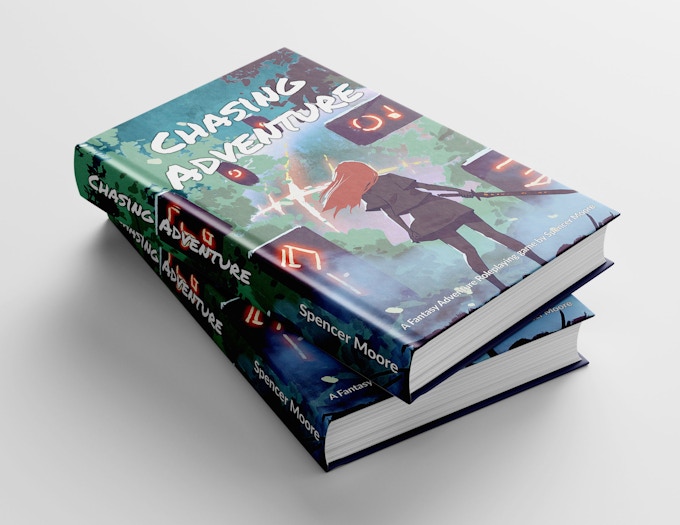You can now back Chasing Adventure on Kickstarter, to get a hardcover copy of the book or to pre-order the PDF. And the game, which used traditional copyright during its development, is now part of the PbtA Commons! So you can integrate its text into your own PbtA hacks, as desired.
The author, Spencer Moore, describes Chasing Adventure as “built to facilitate fast cinematic fantasy action-adventure.” I’ve typically pitched it as “DW-D&D,” that is as Dungeon World minus some elements of Dungeons & Dragons, removing ability scores, hit points, encumbrance, gold pieces, race and alignment. It does add one D&D (5e) element, supporting Advantage and Disadvantage (though each Advantage gives you an extra die).
Differences from Dungeon World
On the DW side, about its last vestige of Dungeon World is that it has the same 10 core playbooks, including the immolator and barbarian.
Chasing Adventure represents a dramatic break from Dungeon World, renaming the basic moves, dropping the Constitution stat, and getting rid of hit points. As a result, you’re not going to be able to easily adapt Dungeon World monsters and starters to Chasing Adventure.
Other differences:
- Leveling has been revamped. You don’t collect XP on failed rolls but on rolling on stats with conditions, giving you a mechanical reason to roll against weaker stats. You also level up every 5 XP, rather than having the threshold needed increase with each level.
- On leveling up, besides taking an advanced move or improving a stat, you can acquire an “Asset,” which can be a literal or figurative asset. Predefined Assets are: apprentice, assistant, artificer, complicated past, connections, familiarity, follower, friend, hideout, home, investment, mount/vehicle, organization, reputation, signature weapon, title. (You can create your own, of course.)
- The Wizard playbook has been generalized. Wizards pick their SPELL stat based on their background: CHA for a Sorcerer, WIS for a Seer, and INT for a Scholar.
Other highlights include some unique Chase moves, a detailed chapter on customizing the system, advice for solo play, extensive random tables, and a lengthy index. There are five adventure seeds (called “Starters” but lacking the NPCs, places, items and the custom moves I’d expect of a starter).
Detailed GM Advice
I really appreciated the detailed advice for GMs.
- The GM moves are expanded to include suggested moves based on the playbooks being used, as in Masks. For instance, here are suggested GM moves for the Paladin: “• Endanger the helpless in their presence • Test their commitment to their Virtues • Introduce a corrupt or rival authority.”
- Many GMs find running non-player characters to be confusing; the section on running NPCS is needed and useful
- The Magic Item list of categories is great.
- I especially liked how Ominous Forces (threats/Fronts) are given examples using each of the three LOTR movies (yes, the movies, not the books).
Conclusion
I had only minor nitpicks with the text. I would like to see:
- A trigger summary, similar to how Freebooters on the Frontier 2e displays the triggerspace.
- More advice on running large battles.
- Advice for converting Dungeon World monsters.
If you want a more PbtA fantasy system than Dungeon World, check out Chasing Adventure!


